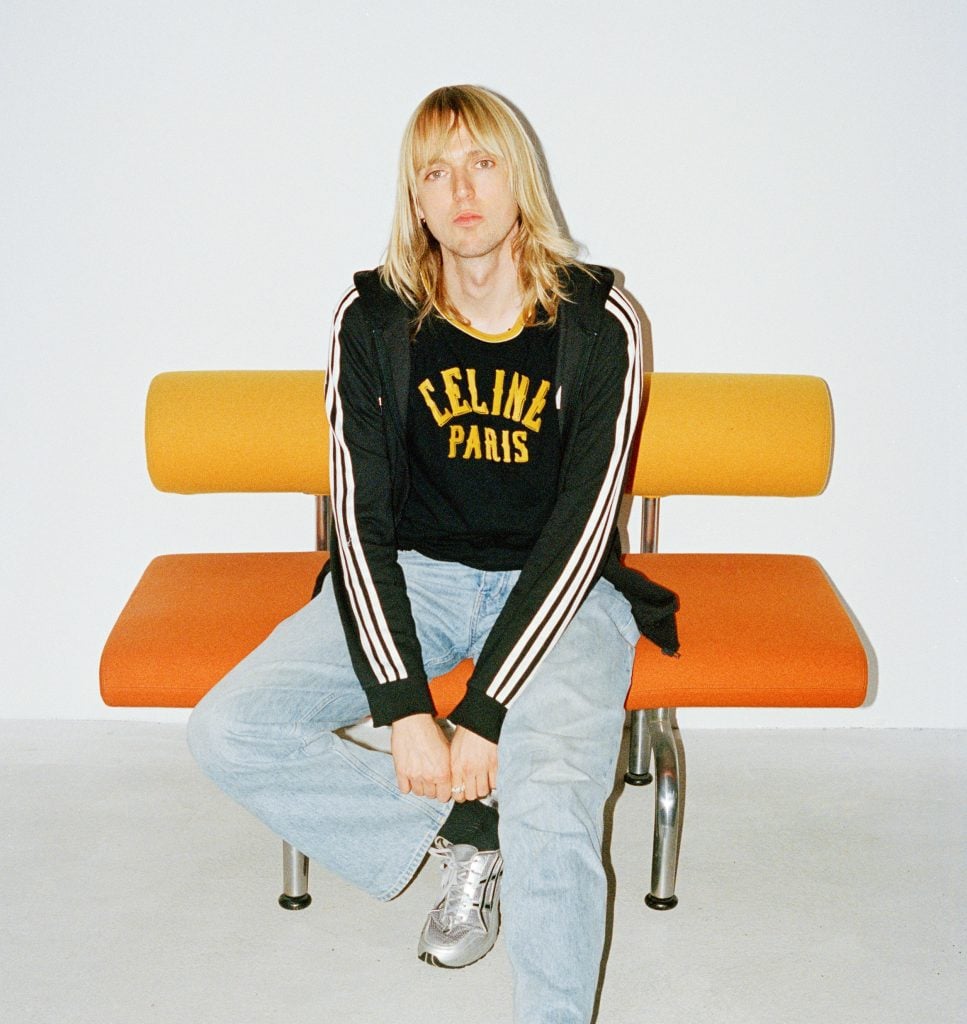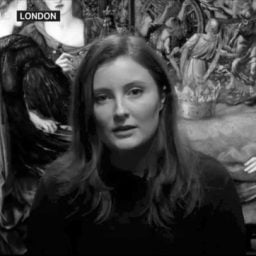From the outside, the gathering looked just like any other art world party in the run up to Frieze. Inside the crowd of smartly dressed guests clutching champagne glasses, however, six figures in various stages of undress staggered, swayed, and skipped around three suspended alien heads. The performance by Danish artist Esben Weile Kjaer marked the launch of Albion Jeune, a new London gallery, last Friday.
It was a danse macabre that could have taken place in a teenage bedroom, with all the expected emotional turbulence. One dancer wore a hoodie over a tutu, another ripped jeans with a chain, and most had faces covered in glitter. Their movements slipped seamlessly from jaunty and agitated to graceful and, at times, tender, as in the case of one play fight that escalated into a moment of charged intimacy. Looming overhead, the extraterrestrial skulls, in sparkling blue and silver had a garish, amusement park aesthetic while also deftly recalling the vanitas-style skulls used in Dutch still life—painterly symbols of death.

Esben Weile Kjaer, I Want to Believe (2023) at 180 Strand on Friday October 6, 2023. Photo: Freja Wewer, courtesy Albion Jeune and the artist.
The performance was fairly tame by Kjaer’s standards. He has turned heads in recent years for staging a string of unusual happenings alongside his sculpture and installation works, which were recently described by curator Hans Ulrich Obrist as “always surprising.”
While still a student in 2020, Kjaer produced Hardcore Freedom at Copenhagen Contemporary that included ten dancers improvising for nearly an hour to recreate the effect of a party spiralling out of control; in one instance, a mass of writhing bodies were bound together with police tape and struggled to break free. Loosely choreographed chaos would go on to characterize subsequent performances like BURN! at Copenhagen’s National Gallery and the Centre Pompidou and HYPER!, presented at Museum Tinguely in Basel and BFI Miami.
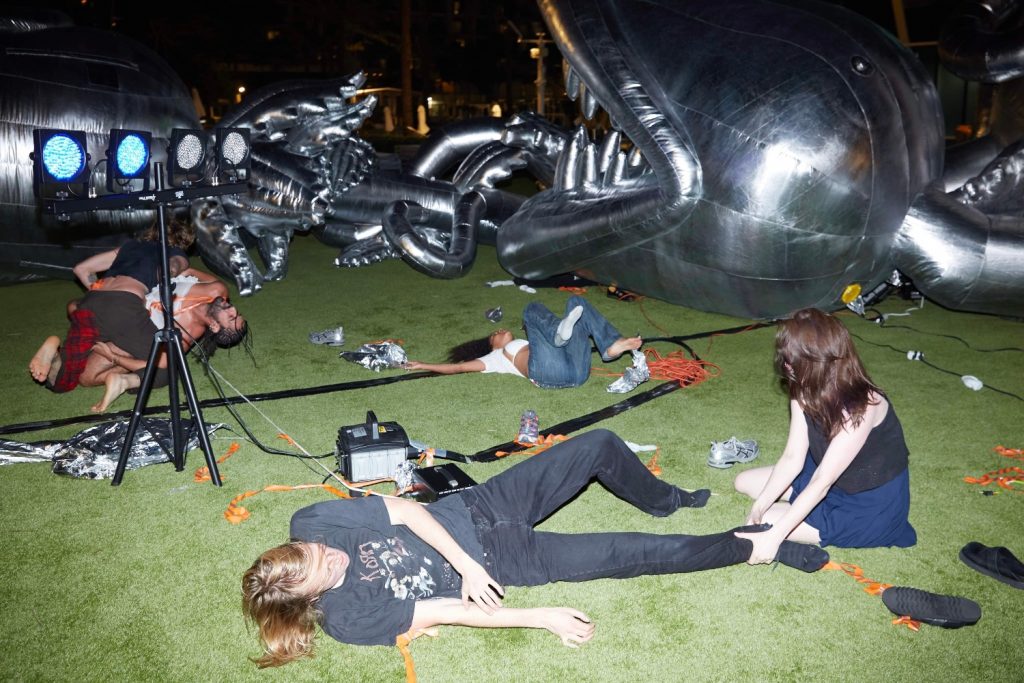
Esben Weile Kjær, HYPER! (2022). Photo: Nick Hudson, © Albion Jeune and the artist.
From a young age, Kjaer was DJing at raves and hosting queer parties in his native Aarhus, Denmark’s second-largest city, and later Copenhagen, where he moved into a squat aged 17. “I was doing full-time activism, mainly parties and Reclaim the Streets,” he recalled of that period, which informed his ongoing interest in nightlife and subcultures. He also began DJing at fashion shows and became captivated by the idea of spectacle. “These events cost so much money to create the perfect image,” he said. “I wondered what would happen if this image merged into something else. If the models acted different than only posing and walking.”
Nonetheless, performance would always be, for Kjaer, who is now 31, a method rather than a standalone artwork. Take BUTTERFLY! at Arken Museum for Modern Art in Denmark, which closes on December 30. Invited to curate works from the collection alongside his own, Kjaer placed pieces by 1990s artists he admire, including Wolfgang Tillmans, Tal R, and Sarah Lucas, within an immersive environment modelled on a classic teenage hangout, the skate park. A huge grinning butterfly weaved his own past into this gaudy nostalgia fest by representing a keyring that held the keys to his childhood home. This symbol of transformation “is a jewel, but is also an insect,” Kjaer noted in a promotional video for Arken, hinting at a darker side to his eye-catching visuals. “Behind the beautiful glossy image, tragedy lurks. That is the way it is with everything.”
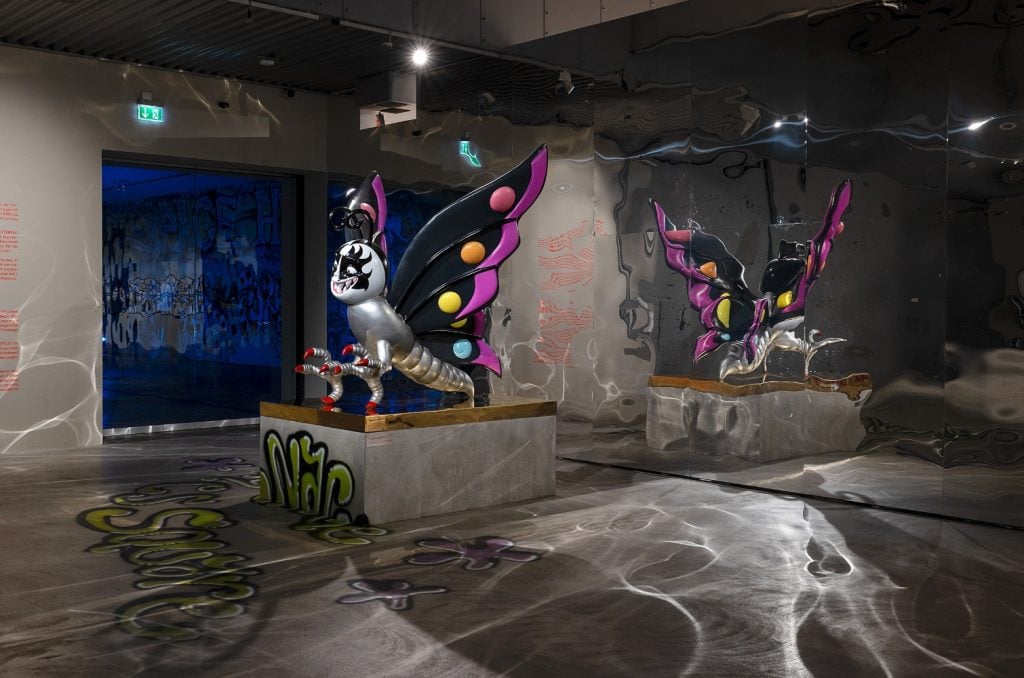
Esben Weile Kjaer, BUTTERFLY! (2023). Photo: Frida Gregersen, courtesy of Arken Museum of Modern Art.
“My performances create still images that later I work further on,” said Kjaer. Photographs documenting a rave-inspired performance at Arken have formed the basis for a new series of “paintings” featured in “I Want to Believe,” the inaugural exhibition at Albion Jeune.
Vividly colored images of figures dancing and kissing with scraps of text like “FIRE STARTER” and “BOLD TRUTH” recall old school-style posters and flyers for concerts and films. Rather than scraps of disposable paper, however, these works are, almost implausibly, made using stained glass. Kjaer, who only graduated from the Royal Danish Academy of Fine Arts last year, began working in this traditionally Medieval crafts medium for his final project.
That stained-glass project, called Mirror, was a “psychedelic, cartoonish” reinterpretation of the infamous Dance Epidemic, an event of plague-induced mass hysteria that took place in Strasbourg in 1518 in which some people danced themselves to death, as well as dancing marathons in the U.S. in the 1920s. “Bodies would collapse right before they were thrown out of the competition,” he said, of his strange fascination with these events. Kjaer prides himself on how clear-cut and contemporary his latest stained glass pieces look. “The clash between this commercial image and historical craftmanship is exciting to me,” he said.
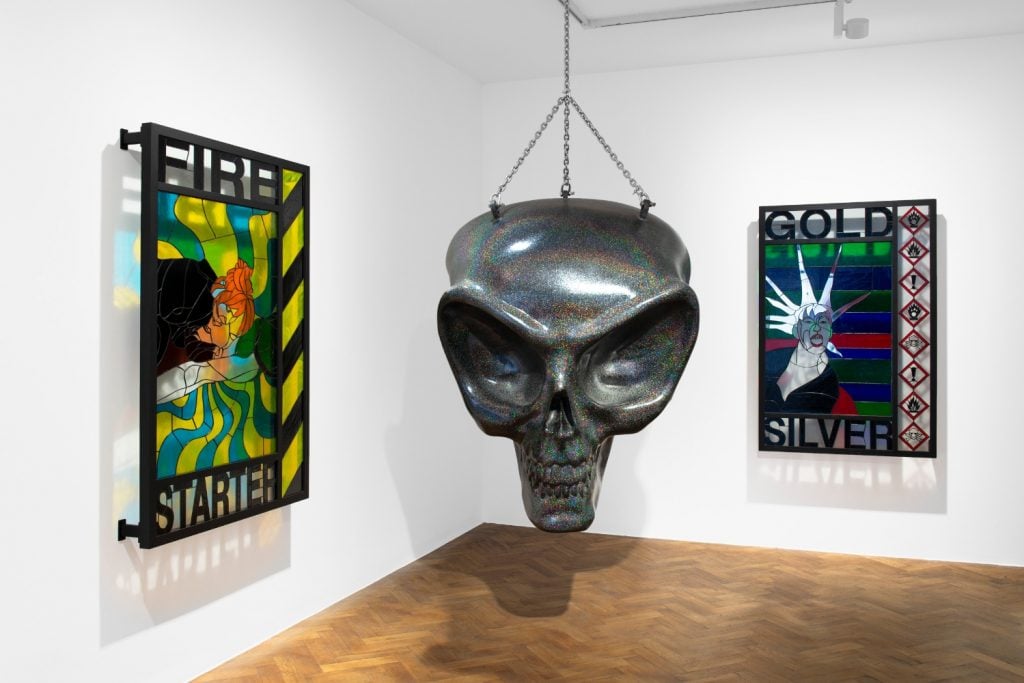
Installation view of Esben Weile Kjaer’s “I Want to Believe,” the inaugural exhibition at Albion Jeune gallery in London. Photo: Todd-White Photography, courtesy of the artist and Albion Jeune, London.
Though he draws on myriad references to pop culture, art history, and his own life, Kjaer use of flashy aesthetics can lend the work an unnerving emptiness or amplify the ways in which it feels nihilistic or perverse. Either way, he captures something about contemporary life that is second nature to a generation that grew up online but is seldom explicitly reflected in high art. “I’m really interested in how pop culture is reproducing itself,” said Kjaer. “Retromania reshaped my idea of how trends are formed. Aesthetics always stand on the shoulder of something else but, as a millennial, I grew up with all these references to the ’90s and ’80s, which were not that long ago. I like the idea of speeding it up.”
“I Want to Believe” runs through November 19, after which Albion Jeune will close to the public again before returning with a revamped look next Spring 2024. Kjaer is currently preparing for a solo exhibition at the Kunsten Museum of Modern Art Aalborg in 2024.
More Trending Stories:
An Elderly Couple Sold a ‘Worthless’ African Mask for $157. Now They Are Suing the Buyer Who Auctioned It for $4.4 Million
A Norwegian Man Stumbled Upon a Trove of Gold Dating to the Early Middle Ages, Including a Rare Pendant Depicting the Norse God Odin
A Top Antiquities Sleuth Has Called Out the Manhattan D.A. For Continually Passing His Work Off As Its Own
Emerging Artist Li Hei Di Calls Her London Studio a ‘Parallel Universe,’ Where Hong Kong’s Cinematic Heroines and Mystical Abstraction Meet
After Its Team-Up With Pokémon, Scalpers Swarm the Van Gogh Museum to Snap Up Merch and ‘Pick the Gift Shop Clean’
An Enigmatic Still-Life Picasso, Made During His Now-Celebrated ‘Wonder Year’ of 1932, Will Hit the Auction Block This Fall
Get a Closer Look at Lagos-Based Artist Nengi Omuku’s Intricate Textile Paintings—Made on Traditional Nigerian Cloth
A Mexican Journalist Went Viral After He Presented ‘Alien Bodies’ to Congress. Now He Is Accused of Plundering Them From Ancient Sites
